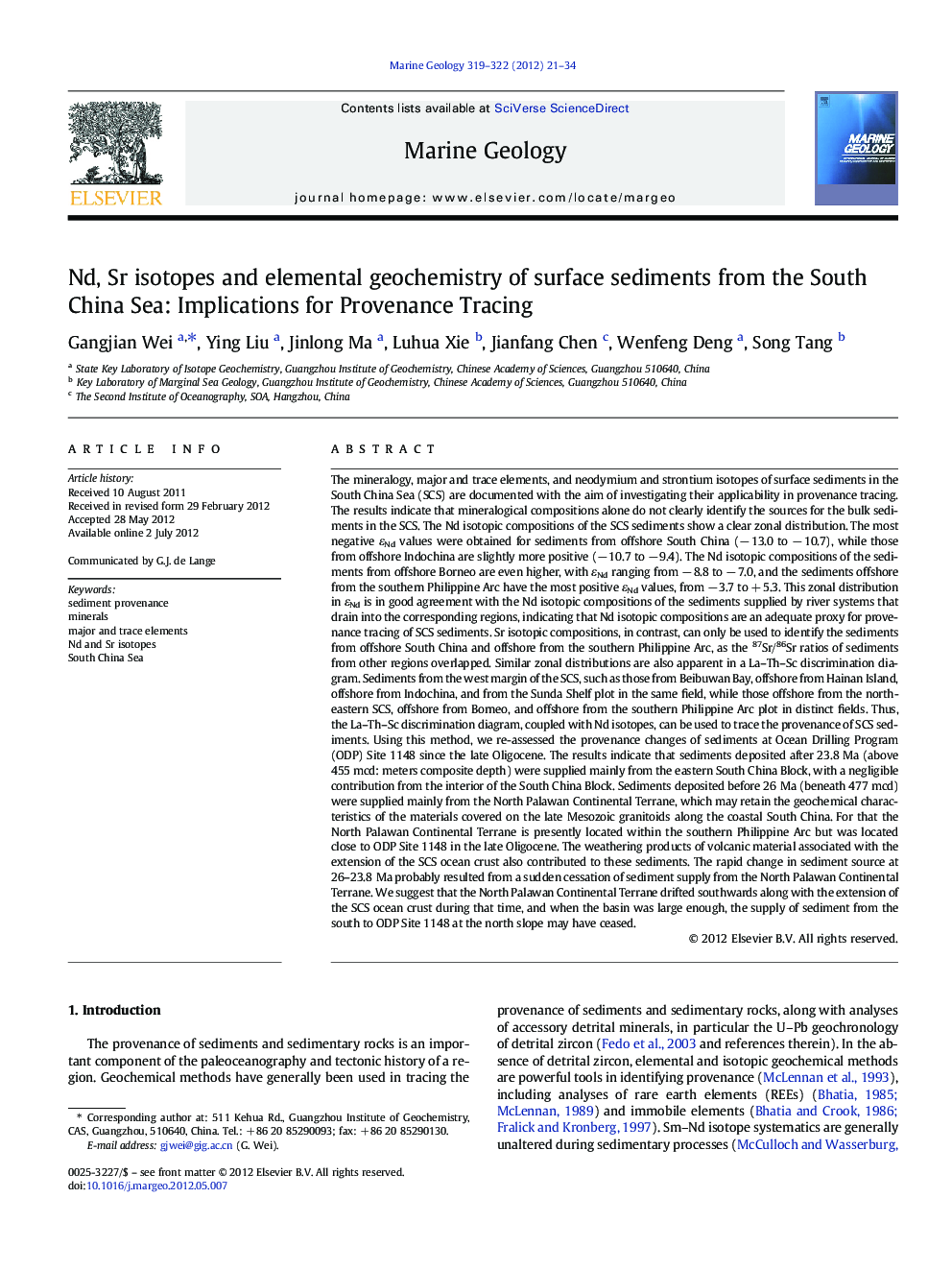| کد مقاله | کد نشریه | سال انتشار | مقاله انگلیسی | نسخه تمام متن |
|---|---|---|---|---|
| 4718527 | 1639122 | 2012 | 14 صفحه PDF | دانلود رایگان |

The mineralogy, major and trace elements, and neodymium and strontium isotopes of surface sediments in the South China Sea (SCS) are documented with the aim of investigating their applicability in provenance tracing. The results indicate that mineralogical compositions alone do not clearly identify the sources for the bulk sediments in the SCS. The Nd isotopic compositions of the SCS sediments show a clear zonal distribution. The most negative εNd values were obtained for sediments from offshore South China (− 13.0 to − 10.7), while those from offshore Indochina are slightly more positive (− 10.7 to − 9.4). The Nd isotopic compositions of the sediments from offshore Borneo are even higher, with εNd ranging from − 8.8 to − 7.0, and the sediments offshore from the southern Philippine Arc have the most positive εNd values, from − 3.7 to + 5.3. This zonal distribution in εNd is in good agreement with the Nd isotopic compositions of the sediments supplied by river systems that drain into the corresponding regions, indicating that Nd isotopic compositions are an adequate proxy for provenance tracing of SCS sediments. Sr isotopic compositions, in contrast, can only be used to identify the sediments from offshore South China and offshore from the southern Philippine Arc, as the 87Sr/86Sr ratios of sediments from other regions overlapped. Similar zonal distributions are also apparent in a La–Th–Sc discrimination diagram. Sediments from the west margin of the SCS, such as those from Beibuwan Bay, offshore from Hainan Island, offshore from Indochina, and from the Sunda Shelf plot in the same field, while those offshore from the northeastern SCS, offshore from Borneo, and offshore from the southern Philippine Arc plot in distinct fields. Thus, the La–Th–Sc discrimination diagram, coupled with Nd isotopes, can be used to trace the provenance of SCS sediments. Using this method, we re-assessed the provenance changes of sediments at Ocean Drilling Program (ODP) Site 1148 since the late Oligocene. The results indicate that sediments deposited after 23.8 Ma (above 455 mcd: meters composite depth) were supplied mainly from the eastern South China Block, with a negligible contribution from the interior of the South China Block. Sediments deposited before 26 Ma (beneath 477 mcd) were supplied mainly from the North Palawan Continental Terrane, which may retain the geochemical characteristics of the materials covered on the late Mesozoic granitoids along the coastal South China. For that the North Palawan Continental Terrane is presently located within the southern Philippine Arc but was located close to ODP Site 1148 in the late Oligocene. The weathering products of volcanic material associated with the extension of the SCS ocean crust also contributed to these sediments. The rapid change in sediment source at 26–23.8 Ma probably resulted from a sudden cessation of sediment supply from the North Palawan Continental Terrane. We suggest that the North Palawan Continental Terrane drifted southwards along with the extension of the SCS ocean crust during that time, and when the basin was large enough, the supply of sediment from the south to ODP Site 1148 at the north slope may have ceased.
► The applicability of mineralogical, elemental and Sr-Nd isotopic geochemistry in provenance tracing was assessed on surface sediments in the South China Sea (SCS).
► Nd isotopes and La-Th-Sc discrimination diagram can adequately identify provenances of the SCS sediments.
► The sediment sources rapidly changed from the North Palawan Continental Terrene before 26 Ma to the eastern South China Block after 23.8 Ma at ODP Site 1148.
► Continuous extension of the SCS oceanic crust accounts for such provenance jump.
Journal: Marine Geology - Volumes 319–322, 1 August 2012, Pages 21–34